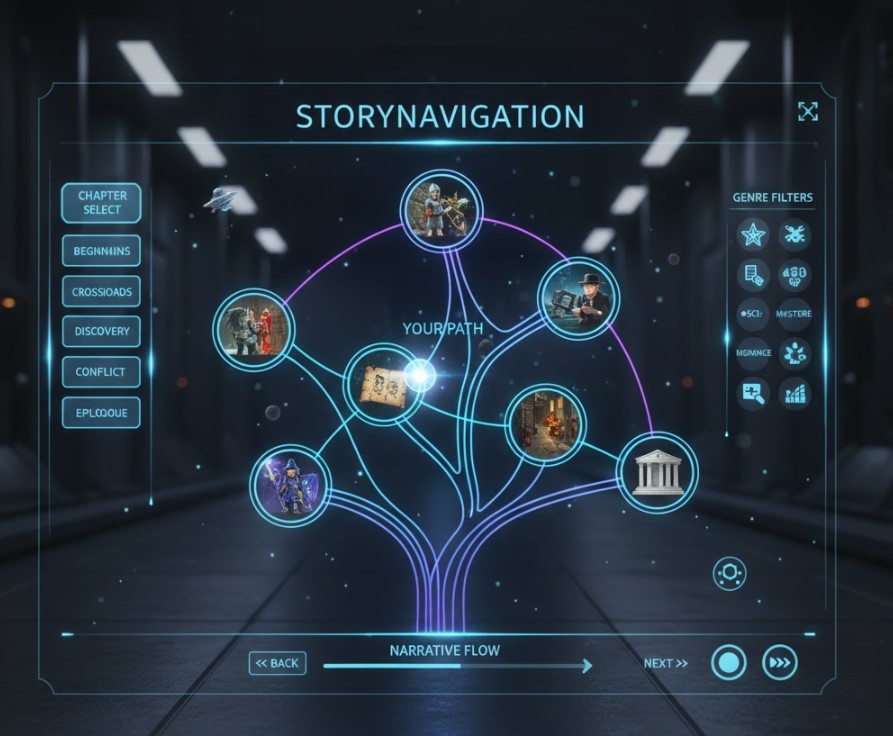Storytelling has always been an essential part of human culture, allowing us to share experiences, emotions, and knowledge across generations. However, traditional storytelling methods, whether oral, written, or visual, have limitations in their engagement. Enter StoryNavigation—a groundbreaking concept that transforms how narratives unfold, offering a dynamic and interactive storytelling experience.
StoryNavigation empowers creators and audiences alike to navigate stories in real-time, enabling customized, immersive experiences. This innovation is particularly relevant in a world where personalization and audience engagement are crucial. In this article, we will explore the power of StoryNavigation, its impact on storytelling, and how it shapes the future of interactive media.
What is StoryNavigation?
At its core, StoryNavigation refers to the ability of a user to actively influence the direction of a narrative. Unlike traditional linear storytelling, where the audience passively consumes the content, StoryNavigation provides control to the user, allowing them to shape the story through choices, actions, and interactions. This makes it an integral tool in fields like gaming, digital media, education, and marketing.
Whether through decision points in interactive books, video games, or digital experiences, StoryNavigation allows for multiple story outcomes based on user decisions, creating personalized and engaging experiences.
Why StoryNavigation Matters
In today’s digital world, engagement is key. Audiences are no longer content with passive experiences; they want to be active participants. StoryNavigation taps into this desire for control, transforming traditional storytelling into a two-way conversation between creator and audience. It encourages deeper emotional investment and enhances learning experiences, making it a powerful tool for businesses, educators, and entertainment creators.
The Evolution of Storytelling
Traditional vs. Interactive Storytelling
Traditional storytelling is linear: the creator dictates the plot, and the audience follows along. In contrast, interactive storytelling, powered by StoryNavigation, is dynamic and non-linear, allowing users to influence the plot through their decisions. This shift from traditional methods to interactive experiences has been made possible by advancements in technology, particularly in the fields of gaming, VR/AR, and digital media.
Early Examples of Interactive Storytelling
One of the earliest examples of interactive storytelling is the Choose Your Own Adventure books, which gave readers the power to choose what would happen next in the narrative. Fast-forward to the present, and we see this concept expanded in digital formats like video games and VR experiences, where the stakes are higher, and the engagement is deeper.
How StoryNavigation Transforms Storytelling
1. Enhanced User Engagement
Traditional media limits the user’s role to being a passive observer. With StoryNavigation, however, the user becomes an active participant, influencing how the story unfolds. This engagement leads to a deeper connection with the story, as the user’s decisions carry weight and impact the outcome of the narrative. Interactive platforms such as Netflix’s Bandersnatch or the video game Detroit: Become Human are prime examples of how StoryNavigation can enhance engagement.
2. Personalization and Customization
In the digital age, consumers expect content that is tailored to their preferences. StoryNavigation allows for the customization of the narrative experience, offering users unique storylines based on their choices. This level of personalization not only enhances user satisfaction but also encourages repeated engagement. Think of it as an interactive version of streaming services, where the user’s preferences drive the content they experience.
3. Expanding Educational and Training Opportunities
StoryNavigation isn’t just for entertainment—it also holds immense potential in education and training. By using interactive narratives, students can explore real-world scenarios and make decisions that reflect real-life consequences. For instance, in medical education, interactive stories could simulate patient scenarios, where the user’s decisions can affect the outcome of the treatment plan.
How StoryNavigation Works
The mechanics of StoryNavigation are relatively simple but highly effective. It is based on decision trees, where each choice the user makes leads to a new path or outcome. This branching structure allows for numerous story possibilities, which can be combined to create a deeply personalized and unique narrative.
Key Components of StoryNavigation
- Branching Narratives: These are decision points where the user chooses one path over another, often affecting the storyline, characters, or outcome.
- User Input: StoryNavigation thrives on user participation. The more engaged the user is with the content, the more influence they have over the story.
- Dynamic Outcomes: Unlike traditional storytelling, StoryNavigation ensures that every choice impacts the direction of the story, leading to diverse and multiple outcomes.
Examples of StoryNavigation in Action
- Video Games: Games like The Witcher 3 and Mass Effect use StoryNavigation to let players shape the narrative through their decisions. Choices made during quests, dialogues, or actions affect the game’s plot, character relationships, and even the game’s ending.
- Interactive Films: Netflix’s Bandersnatch allows viewers to make decisions for the main character, influencing the story’s direction and outcome. This immersive approach to film breaks the traditional mold, offering a truly interactive cinematic experience.
- Interactive Fiction and Apps: Apps like Twine and platforms like StoryStream allow users to create and experience interactive stories with multiple branching paths, offering endless possibilities.
Benefits of StoryNavigation
1. Increased Retention Rates
For businesses, incorporating StoryNavigation into marketing strategies can lead to higher engagement and retention rates. By providing an interactive experience where users can explore different aspects of a brand or product, businesses can keep audiences invested in the content longer, driving higher levels of interaction.
2. Emotional Connection
When users actively shape the story, they become emotionally invested in the outcomes. This emotional connection is powerful and can be leveraged in various fields, including marketing and customer experience. A user’s choices within a narrative make the story personal, fostering deeper engagement and loyalty.
3. Scalability and Adaptability
Unlike traditional static content, StoryNavigation allows for a scalable experience that can be continuously expanded and adapted. New story arcs, characters, and pathways can be introduced as the user base grows, keeping the content fresh and exciting. This adaptability makes StoryNavigation a sustainable strategy for long-term engagement.
Applications of StoryNavigation
1. Marketing and Advertising
Interactive storytelling is an emerging trend in marketing. Brands are using StoryNavigation to allow consumers to interact with their advertisements in meaningful ways. This could include choosing product preferences, customizing their own experiences, or engaging in narrative-driven campaigns. Companies like Coca-Cola and Nike have already used interactive videos to personalize their brand storytelling.
2. Education
Educational content is increasingly adopting StoryNavigation to offer engaging learning experiences. For example, medical students can practice decision-making skills in simulated environments where each choice impacts the scenario’s outcome, providing a hands-on learning experience.
3. Corporate Training
StoryNavigation can be applied in corporate training to create immersive, scenario-based learning. Employees can navigate through interactive modules where they make decisions that simulate real-world situations, enhancing their problem-solving skills.
Challenges and Considerations
Despite its advantages, StoryNavigation does present certain challenges that need to be addressed:
- Complexity in Development: Creating interactive narratives with multiple branching storylines requires a significant amount of resources and expertise. It involves a complex structure of decision trees and scenarios.
- User Overwhelm: While interactivity is a draw, too many choices can overwhelm the user, potentially leading to decision fatigue. It’s essential to balance the freedom of choice with clear, engaging story arcs.
- Technical Limitations: Depending on the platform, StoryNavigation can be constrained by technological limitations, such as memory usage, user interface complexity, or platform compatibility.
The Future of StoryNavigation
As technology continues to evolve, so too will the capabilities of StoryNavigation. With the rise of virtual and augmented reality, immersive experiences will become even more integrated into storytelling. We can expect more sophisticated StoryNavigation tools that offer even greater personalization, increased engagement, and richer user experiences.
Additionally, the use of AI to analyze user preferences and predict narrative outcomes will further enhance StoryNavigation, allowing stories to adapt in real-time to user behavior.
Conclusion
StoryNavigation is revolutionizing the way we experience stories. By offering users the ability to influence the narrative, it creates a more engaging, personalized, and interactive experience. Whether in video games, marketing, education, or entertainment, the potential for StoryNavigation to transform content is vast and exciting. As technology advances, the line between creator and consumer continues to blur, paving the way for a future where storytelling is not just consumed but lived.
FAQs
1. How does StoryNavigation differ from traditional storytelling?
StoryNavigation allows the user to actively participate in shaping the narrative, whereas traditional storytelling is linear and predetermined by the creator.
2. Can StoryNavigation be used in marketing campaigns?
Yes, many brands are already using interactive storytelling to engage consumers. It allows for personalized, immersive experiences that can drive deeper brand loyalty.
3. What industries benefit the most from StoryNavigation?
Industries like gaming, education, marketing, and corporate training are some of the primary sectors benefiting from StoryNavigation. These fields use it to enhance engagement, personalize experiences, and improve learning outcomes.
4. Is StoryNavigation scalable for large audiences?
Yes, StoryNavigation is highly scalable. As user preferences are captured, new storylines and decision paths can be introduced, keeping the content dynamic and relevant.
For More Updates Visit: Biomagazine








Leave a Reply